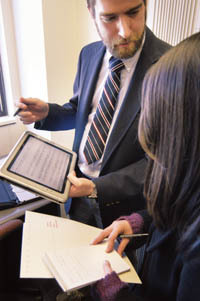
GRADUATE STUDENTS at Brown's new Microsoft Center for Pen-Centric Computing are working on new technologies such as the MusicPad, above, which allows composers to hand-write music notes on a tablet PC.
If words are your language, a keyboard is your friend. With a little help from a mouse, you can easily enter text, edit it and fully convey your thoughts.
But what if you speak the language of chemistry? Computerizing models of molecules so they can be rendered and manipulated in 3-D can be really helpful, but how do you input the data? It’s so easy to hand-draw a sticks-and-circles model, but virtually impossible to type one in.
Researchers at Brown University have come up with a solution: a program that allows you to hand-draw models on a tablet PC, using a pen-like stylus, and have the computer read and interpret them. They call it the ChemPad. They’ve also created a MathPad and a MusicPad.
Now, to help them further develop pen-based applications, the Microsoft Corp. has pledged $1.2 million over the next three years, plus access to its own experts in Redmond, Wash., and in China. It’s the first alliance of its kind in the nation, Brown said.
“Pen-based computing has the potential to alter the way students and teachers interact,” said Rick Rashid, senior vice president of research at Microsoft. “Together with Brown University, we will create new ways of combining the pen and the computer to positively affect not only the educational process, but our working methods and our culture.”
At the helm of Brown’s initiative is Andries van Dam, vice president for research but, more important in this case, a pioneer in computer graphics, hypertext and interactive images, widely published author and teacher of many of today’s industry leaders.
A research group led by van Dam has been designing and testing gesture-recognition software for more than a decade, and Microsoft has partially financed their efforts for four years.
“Brown has really taken a leadership role in pen-centric computing,” Rashid said at a news conference on Monday. “What you’re seeing now is both Brown and Microsoft stepping up to the next level in terms of our research in this area.”
Microsoft is funding centers around the world to address other aspects of computing, Rashid said, and all share the same goal: to be a catalyst so “we can make things happen that might not otherwise be possible.”
With the new grant, Brown will create the Microsoft Center for Pen-Centric Computing – for now, just a two-room space where graduate students continue their longtime research, but eventually, van Dam hopes, a much larger operation. “They view this as a sort of seed investment, and we’re supposed to become self-sufficient at the end of that term,” he said.
Already, the center is in talks with a “government entity,” van Dam said, and it’s working with the R.I. Economic Development Corporation to try to test the MathPad in some local schools. In addition, the center will reach out to other industry players, he said. IBM, Sun Microsystems and other major companies have financed previous projects.
The intellectual property will not belong to Microsoft; Brown has the right of first refusal to acquire any technology developed by the researchers, van Dam said, and it can then license it to Microsoft – exclusively or non-exclusively – or to any other company.
Given Microsoft’s size, van Dam added, chances are that it won’t really be that interested in commercializing pen-based technologies directly. The company is far more interested in products with “multibillion-dollar” potential, and these programs would serve niche markets.
“What they love is for other companies to develop these things,” van Dam said. “They’re very keen on evangelizing the [Windows] platform, and that requires good software to run on it.”
And at that level, van Dam said, the potential is endless. Because the truth is, there are lots of tasks for which using a keyboard and a mouse is “very unnatural,” he said, whereas using a pen is perfect.
“In some cases, the pen is mightier than the keyboard,” van Dam said. “Chemists and composers, archaeologists and artists all need pen and paper to create and communicate. We can help them do their work digitally, in a way that is as easy and natural as drawing on paper.”
The basic technology – pads you can write on with a stylus – is already widely available, in the form of tablet PCs, personal digital assistants and electronic whiteboards, among other things. But beyond handwriting recognition software, van Dam said, there’s virtually no technology out there to support the kinds of applications his team is creating.
“We’re inventing it from the get-go,” he said.
“Part of this research is about how people could use these technologies: what is natural, what works best,” added Rashid. “I think the goal here is to create a set of technologies that are broadly applicable.”












